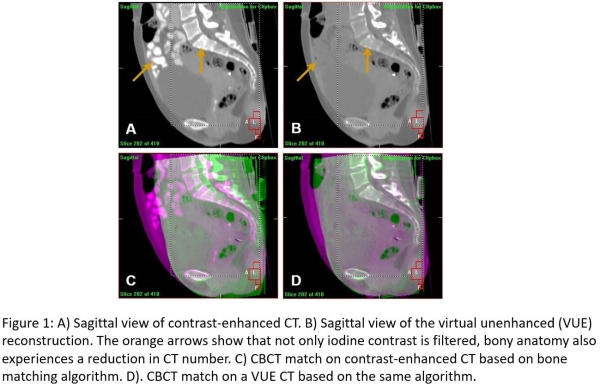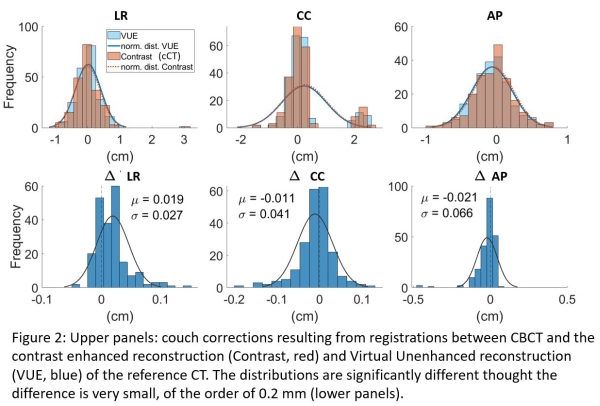Virtual Unenhanced Dual Energy CT improves position verification compared to contrast CT
MO-0391
Abstract
Virtual Unenhanced Dual Energy CT improves position verification compared to contrast CT
Authors: Loes Bulthuis1, Maryam Afifah2, Karin Goudschaal1, Duncan den Boer1, Tezontl Rosario1, Jolanda Verbeek1, Arjan Bel1, Zdenko van Kesteren1
1Amsterdam UMC, Radiotherapy, Amsterdam, The Netherlands; 2Amsterdamumc, Radiotherapy, Amsterdam, The Netherlands
Show Affiliations
Hide Affiliations
Purpose or Objective
Iodine contrast is commonly used to aid delineation in radiotherapy. However, this contrast is not present during treatment and needs to be accounted for during treatment planning and position verification. Dual-Energy CT (DECT) is an emerging CT technique with the capability of generating virtual unenhanced (VUE) reconstructions from contrast-enhanced acquisitions. A concern is that VUE images show reduced CT intensity in high density regions outside the contrast-enhanced structures, e.g. bones, see Figure 1(A/B). This potentially influences the CBCT-based position verification at conventional linacs.
The aim of this study is to assess the position verification accuracy by comparing CBCT registrations to VUE CT reconstructions with CBCT registrations to the contrast CT.

Material and Methods
Ten gynecological patients, treated for 25 fractions, were included in this study. Iodine-based contrast agent was administered before acquiring a DECT scan (Revolution CT, GE Healthcare). Contrast consisted of intra-venous contrast, bowel contrast and vaginal contrast. Two reconstructions were made: one contrast CT (cCT, our clinical standard) and a VUE reconstruction.
A strict position verification protocol was used, e.g. an automatic registration with fixed region of interest (ROI) and registration algorithm (chamfer match algorithm, XVI, R5.0.4, Elekta). For this study, 250 CBCTs were retrospectively registered on the contrast CT and compared to the same CBCT to VUE image registrations (VUE). We recorded translation couch corrections in LR, CC and AP-direction resulting from the registration, thus after correcting for rotations in the center of mass of the target structure. We analysed the frequency of registrations with poor quality, based on visual assessment (Figure 1C). These registrations were excluded in the analysis of differences between cCT and VUE registration results. A Student t-test was used to determine significance (α = 0.05).
Results
Using the cCT with the strict registration protocol, 36/250 CBCT registrations were of poor quality, due to the presence of contrast enhanced structures in the ROI. This occurred in 4 patients (21, 7, 7 and 1 occurrences). This did not occur in the VUE registrations (e.g., Figure 1D).
Comparing couch shifts from the remaining 214 successful automatic registrations, the VUE and cCT yielded similar results (upper panes Figure 2). The differences of cCT versus VUE registrations for the three cardinal directions were significant (p<0.001) but small, a mean difference of 0.2, 0.1 and 0.2 mm was observed for the LR, CC and AP-direction respectively.

Conclusion
Virtual Unenhanced DECT for CBCT position verification with an automatic bone match does not suffer from contrast enhanced structures in the region of interest resulting in acceptable registrations in all fractions. The resulting couch corrections differences using VUE are significant though small compared to contrast enhanced CT, with a mean difference of less than 0.2 mm.